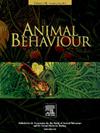利用盘翅蝙蝠特有的栖息范围,三色甲状腺翅目
IF 2.3
2区 生物学
Q2 BEHAVIORAL SCIENCES
引用次数: 0
摘要
资源专门化程度高的物种经常表现出领土行为,以确保获得重要资源。在这里,我们研究了T. tricolor社会群体的栖息范围,T. tricolor是一种以专门利用正在发育的管状叶子作为栖息场所而闻名的蝙蝠物种。我们的主要目标是通过分析栖息范围之间的重叠程度及其与管状叶每日可用性的关系来检查领土性的潜在发生。我们还探讨了群大小、栖息范围大小和这些范围内管状叶丰度之间可能的相关性。我们的研究结果表明,社会群体保持着专属的栖息区域,邻近群体之间的重叠很少,特别是当栖息地点密度适中时。群落大小与栖息范围大小、管状叶数之间无显著关系。基于我们的研究结果,我们自信地提出在这个物种中存在领土行为。本文章由计算机程序翻译,如有差异,请以英文原文为准。
Use of exclusive roosting ranges in disc-winged bats, Thyroptera tricolor
Species displaying high levels of resource specialization frequently exhibit territorial behaviour to secure access to vital resources. Here we studied the roosting ranges of T. tricolor's social groups, a bat species known for its specialization in using developing tubular leaves as roosts. Our main goal was to examine the potential occurrence of territoriality by analysing the extent of overlap between roosting ranges and its association with the daily availability of tubular leaves. We also explored the possible correlation between group size, the size of roosting ranges and the abundance of tubular leaves within these ranges. Our findings revealed that social groups maintained exclusive roosting areas, with minimal overlap observed among neighbouring groups, particularly when the density of roosting sites was moderate. No significant relationship was observed between group size and roosting range size or the number of tubular leaves within these ranges. Based on our results, we confidently propose the existence of territorial behaviour in this species.
求助全文
通过发布文献求助,成功后即可免费获取论文全文。
去求助
来源期刊

Animal Behaviour
生物-动物学
CiteScore
4.60
自引率
8.00%
发文量
236
审稿时长
10.2 weeks
期刊介绍:
Growing interest in behavioural biology and the international reputation of Animal Behaviour prompted an expansion to monthly publication in 1989. Animal Behaviour continues to be the journal of choice for biologists, ethologists, psychologists, physiologists, and veterinarians with an interest in the subject.
 求助内容:
求助内容: 应助结果提醒方式:
应助结果提醒方式:


